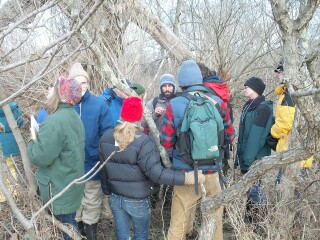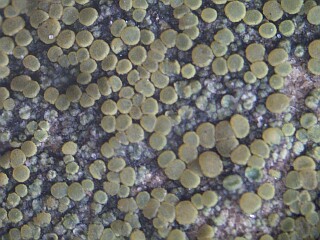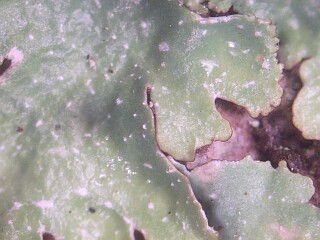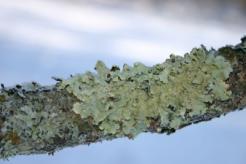Likeable Lichens - Lick Brook Lichens
When
What
Who
Description
David Werier and Natalie Cleavitt team up for the ever-popular winter lichen walk. Dress warmly (we may be moving slowly) and bring a 10x hand lens if you have one. Meet at CCE at 1PM to carpool.
Report
LICHEN OUTING AT LICK BROOK
About fifteen people attended this outing led by David "Nakita" Werier. As with all outings, we met at the Cornell Cooperative Extension off Willow Avenue. Before going to the fields, David introduced everyone to lichens.
Lichens are a symbiosis between fungi and a photobiont (either algae or cyanobacteria or both). There are three broad groupings of lichens: Foliose, a "leafy" type; Fruticose, having a "shrubby" appearance and "Crustose", a crusty type which grows into the substrate that it lives on and cannot be removed from it. The topmost layer, the one we see, is called the upper cortex. Just below this layer is an algal layer. The cortex allows light to pass to the alga which can then produce energy needed by the lichen. Below the algal layer is the medulla. This can be an important layer in identifying the lichen. Although white in most species, the medulla in some species is yellow, red or some other distinctive color. Scraping the cortex to reveal the color of the medulla is one of the aids in identifying the species in the field.
Lichens use both vegetative and sexual means to reproduce. In vegetative propagation, structures called isidia and soredia break off from the parent plant and can grow new plants when the right conditions exist. In sexual reproduction, lichens have bodies called "Apothecia" in which spores form. The spores result from the fungal element and are unable to produce a new lichen unless they encounter the right species of algae in the appropriate habitat. Despite such a seemingly difficult occurrence, lichens abound in our landscape.
Following the lecture, we carpooled out to Lick Brook. Although the temperature was only 20 degrees, the sunny day and our enjoyment at finding so many interesting and attractive lichens kept everyone warm. The picture to the left shows David, in the center, describing some of the lichens we would find. The first one we found was Flavoparmelia caperata, a common bright green foliose lichen that we've probably all seen. By the way... the pictures on this page were all taken on the outing.
A hand-lens reveals the identity of a lichen that looks similar to others. Does it have apothecia? Soredia? Rhizines? Is it on bark? Rock?
The picture to the right is a species of Caloplaca, one of the lichens we found. The yellow circular bodies are the apothecia. It looks similar to C. feracissima but it was found on sedimentary rock and normally feracissima is found on calcareous rock. Because of this, determination of the species could not be done in the field.
The picture to the left is of Punctelia rudecta, one of the ones we got to know at Lick Brook. It is very common and has distinctive white dots on the thallus surface. These dots are pseudocyphellae, white pores on the thallus surface caused by a break in the cortex through which the medullary hyphae emerge onto the surface.
| Latin Name | Common Name |
| Flavoparmelia caperata | Common greenshield lichen |
| Arthonia caesia | Frosted Comma lichen |
| Caloplaca cf. feracissima | Sidewalk firedot lichen |
| Candelaria concolor | Candleflame lichen |
| Candelariella efflorescens | Powdery goldspeck lichen |
| Graphis scripta | Elvin script lichen |
| Lecanora cf. strobinina | Mealy rim-lichen |
| Lecanora thysanophora | Mapledust lichen |
| Melanelia subaurifera | Abraded camouflauge lichen |
| Phaeophyscia pusilloides | Pompon shadow lichen |
| Phaeophyscia rubropulchra | Orange-cored shadow lichen |
| Physcia millegrana | Mealy rosette lichen lichen |
| Porpidia albocaerulescens | Smoky-eye boulder lichen lichen |
| Punctelia rudecta | Rough speckled shield lichen |






